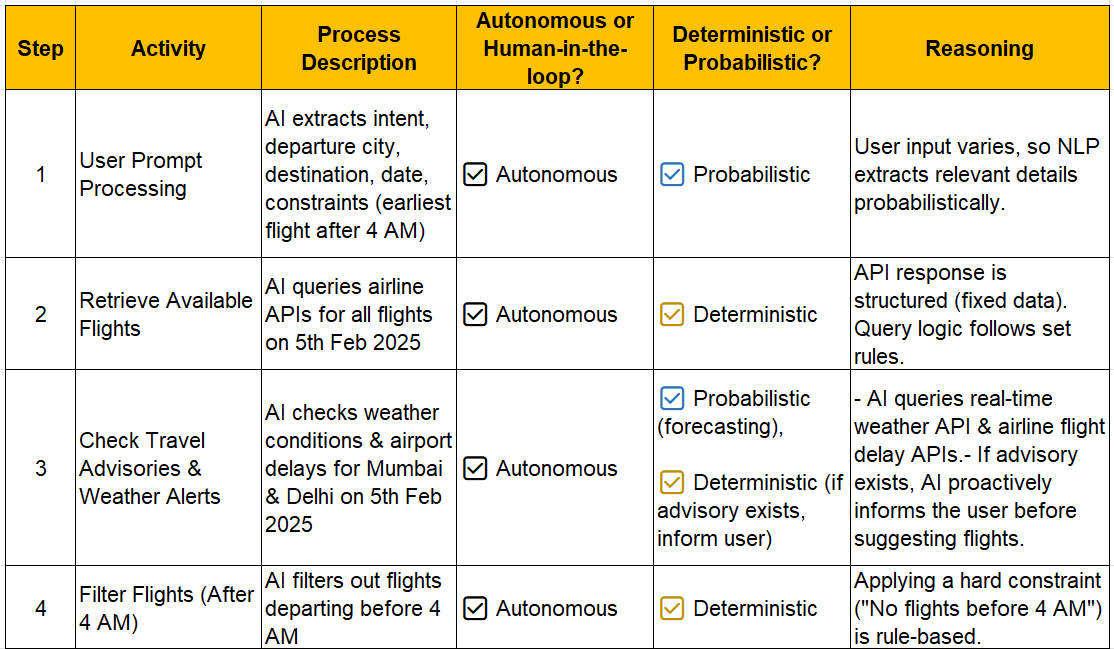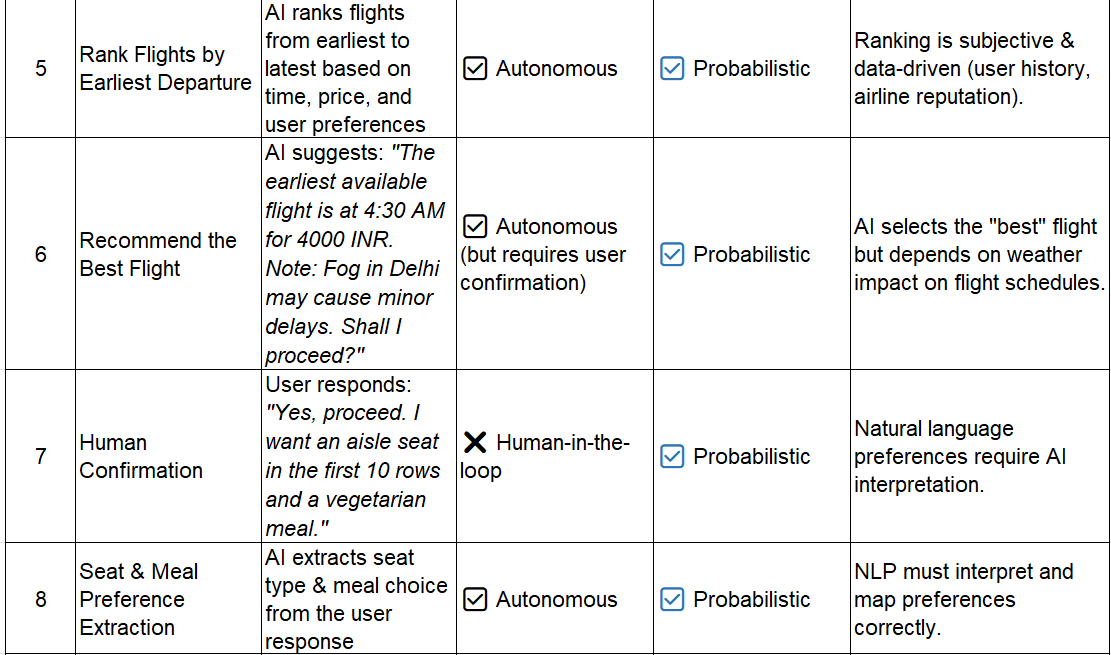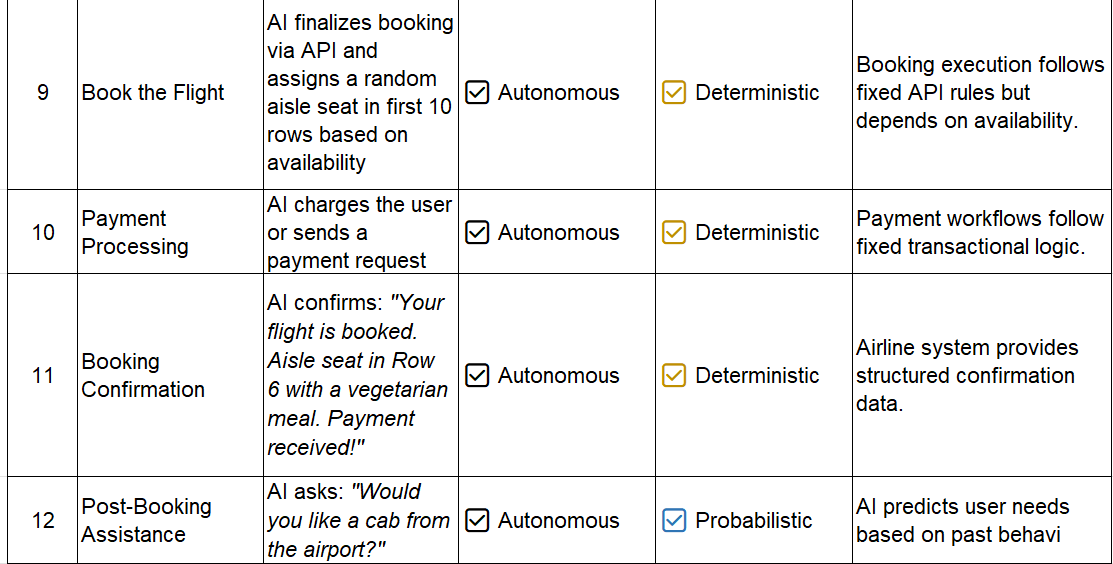Understanding Deterministic and Probabilistic AI in Agentic Workflows
How AI balances fixed rules and adaptive decision-making to enable autonomous workflows.
“If there's one thing in AI that one should pay attention to, it's Agentic AI.”
-Andrew Ng
The AI Agentic Workflow is a fascinating development. The more I explore how complex it is for machines to autonomously mimic human behavior, the more I realize how much we take our cognitive and reasoning abilities for granted.
Everyday tasks like booking a meeting, driving, or making tea involve a series of coordinated actions that feel effortless because our brain optimizes them over time. Through neuroplasticity, repeated behaviors strengthen neural pathways, making these tasks feel second nature. But for machines, achieving human-like reasoning requires computational models that simulate cognitive processes—blending deterministic logic for structured tasks with probabilistic reasoning for uncertainty.
The rise of agentic AI workflows is making this seemingly impossible feat a reality, and that’s exciting. As I explore this space, I want to map which aspects of AI behavior are deterministic (rule-based and predictable) and which rely on probabilistic decision-making (adaptive and uncertain).
You may have heard of rule-based automation and robotic process automation (RPA)—which are purely deterministic. These systems follow predefined workflows where given the same input, the same output is always produced. However, AI extends beyond deterministic logic into probabilistic reasoning, where uncertainty and adaptive decision-making play a role.
It’s important to note that all AI processes fall into one of these three categories:
Deterministic AI follows strict rules and produces predictable outputs.
Probabilistic AI assigns probabilities to decisions based on uncertainty and adaptation.
Hybrid AI combines deterministic rules with probabilistic decision-making, ensuring structured execution while allowing adaptability.
Now that we’ve set the context, let’s explore the three core characteristics of AI agentic workflows. If you’re interested in learning more about Agentic AI, check out my earlier blog on the topic.
Three core characteristics of AI agentic workflows
Continuous Learning – Agentic workflows integrate past interactions, data, and user feedback to continuously improve results. Unlike traditional automation, these systems evolve over time through reinforcement learning or adaptive models.
Reflection & Independent Decision-Making – AI agents proactively critique their own outputs, identify flaws, and refine their approaches without requiring explicit user input. This mimics human metacognition, allowing AI to self-correct and optimize behavior.
Intelligent Collaboration – AI agents work with other systems, microservices, or humans to divide tasks, exchange information, and reach goals more efficiently through multi-agent systems. (source: scalablepath)
Applying this concept to flight booking
A great example of this in action is Operator.ai, an exciting development from OpenAI that applies AI agentic workflows effectively. Although I haven’t personally tried it (since it’s not available in India yet), the demo showcased how an AI agent can autonomously process complex tasks, making intelligent decisions while consulting with humans when needed.
If you’re a product manager trying to map this concept, here’s how I broke it down for a flight booking use case:
Can this be related to any existing architectures?
You can think of AI agentic workflows like microservices in software development. Just as microservices break down a monolithic system into smaller, independent services, AI agentic workflows decompose a complex process into micro-agents—specialized AI components that execute specific tasks while coordinating with others.
Like microservices communicating via APIs, these AI agents exchange structured data, prompts, or function calls to complete their tasks efficiently. Designing these micro-agents with an API-first mindset—along with effective context management and reasoning mechanisms—is crucial for scalability and seamless automation.
Even in the human brain, completing a complex task—like checking the rearview mirror while reversing a car—requires millions of neurons firing in parallel, with each neuron playing a specialized role in a larger network. These interconnected neurons work collaboratively to handle various sub-tasks, such as visual perception, motor control, and spatial awareness. Similarly, agentic AI systems distribute cognitive load across multiple task-specific agents that interact and collaborate to execute tasks more efficiently, mimicking human-like automation.
Exciting times ahead! :)





